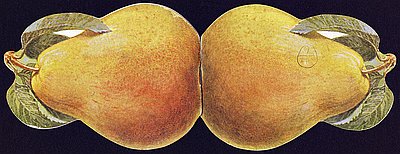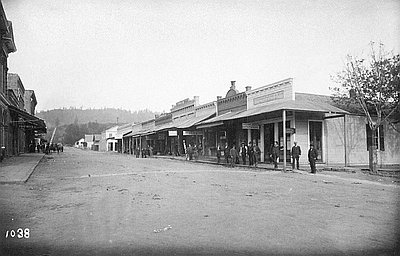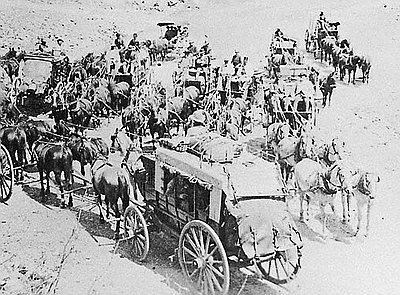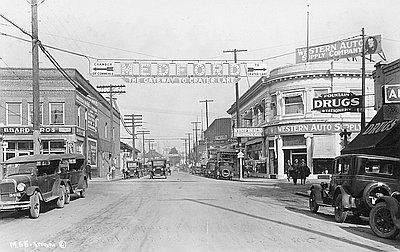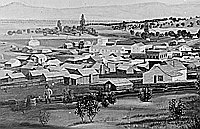Southwestern Oregon’s economy worsened after 1893, when the nation plunged into a deep financial depression. Local tensions were intensified during those difficult times, fueling the rise of the People’s (Populist) Party. The party’s national agenda of reform saw local expression in the deep resentment held by Jackson County Populists—most of them farmers—toward both established Jacksonville Democrats in the county courthouse and Republican leaders in Ashland.
After 1900, general economic recovery and a nationwide demand for fresh fruit led to an orchard boom in the Rogue River valley. New refrigeration capabilities on the Southern Pacific Railroad line enabled growers to ship fruit to distant markets. Widespread publicity about the region’s beauty brought prospective orchardists to the region, all hoping to make fortunes from fruit trees.
“Everybody, young and old, rich and poor, saint and sinner,” the Reverend F.W. Gookin of Medford observed, “is engaged in picking, drying, packing, or shipping fruit.” Local men picked fruit, and both women and men worked in the packinghouses. “[We] used to camp out in tents under a pear tree during the packing season,” observed one packinghouse worker. “We’d go out on Monday morning, and take provision enough to stay all week and then come in on Saturday night.”
Local officials platted forty-five additions to Medford between 1905 and 1909, and thirty-nine more between 1910 and 1912. In 1910, the town’s population reached 8,849 residents, an increase of 393.5 percent in ten years. By 1915, however, the lack of dependable irrigation hindered tree growth, and many orchards failed. After Jackson County suffered a severe post-World War I economic depression, fear resurfaced among residents who again looked with distrust on those they saw as wealthy and elitist.
This economic uncertainty left many people vulnerable when Ku Klux Klan recruiters arrived in southwestern Oregon to enroll new members. The Klan had gained important political ground after 1920; and in 1922, with as many as twenty-five thousand members registered throughout the state, the organization saw many of its endorsed candidates elected to office.
“No doubt many were attracted largely by its secret rituals, hooded robes, program of moralistic regulation…and its pose as the savior of traditional, white Protestant America,” historian Jeffrey LaLande observes. Klan representatives successfully exploited local resentments while promoting support for a doctrine that espoused white supremacy, anti-Catholicism, and anti-Semitism. The Klan agenda attracted orchardists who were worried about irrigation rights and, LaLande writes, “rural folks suspicious of Medford’s affluent newcomers.”
Hooded Klan associates kidnapped local Rogue River Valley men in separate instances, tied them to trees, and threatened them with hanging. Medford Mail Tribune owner and editor Robert Ruhl vigorously opposed the Klan at every turn. “For the third time during the past few weeks,” Ruhl wrote in April 1922, “self appointed masked and armed bands were abroad creating terror last Sunday night and adding much to the apprehension of the people of the valley.”
The Klan’s political power faded by the mid-1920s and growing financial difficulties brought about its decline in the state and in southern Oregon, but Klan-inspired fear and suspicion festered in the region for years.
Orchardists were not the only ones to suffer when the Depression hit the region after 1929. Banks closed, businesses failed, and workers lost jobs in towns and lumber camps. Families eked out a living on marginal lands, and officials tried to maintain services on very little money. In southwestern Oregon, where the economy traditionally centered on the extractive industries of mining and logging, two events markedly affected residents’ abilities to endure the Depression: the creation of the Civilian Conservation Corps (CCC) and the 1934 increase in gold value to $35 per ounce, the first increase in almost a century.
In 1933, President Franklin D. Roosevelt initiated several New Deal programs to solve the immediate problem of relief for the unemployed, including the Public Works Administration and the Works Progress Administration (WPA). Among these, the CCC played an important role in combating the region’s economic crisis. Between 1933 and 1941, young men from urban areas joined the CCC to complete construction and conservation projects. Most of the projects began in conjunction with the U.S. Forest Service, whose managers oversaw CCC crews in fire suppression, road construction, and building construction. The program brought financial relief to the region by purchasing materials from local businesses.
For other regional residents, the 1934 increase in the price of gold sparked a new generation of prospectors. The Depression era’s lower labor costs and reduced materials costs encouraged small-scale gold mining along the Illinois and Rogue Rivers and their tributaries. Men worked old mines and searched out new ones. Known as “snipers,” prospectors dug out soil and gravel and panned for nuggets. Others dug deep pits or “glory holes” from which to draw soil and rock. “I worked up and down the [Rogue] river,” miner Red Keller recalled. “I always had an ax, shovel and small picks….we’d move from place to place.”
Jackson County commissioners ruled that indigents could mine their own property as well as government lands, thereby reducing relief funds that the county would otherwise be obligated to pay. In Jacksonville, dozens of small mining operations soon got underway, some on home ground. “Where else can a home-owner burrow in his backyard and produce ham, bacon, and other condiments?” wrote the editor of the Jacksonville Miner in 1932.
The region’s gold production rose sharply during the Depression decade, more than tripling between 1930 and 1940. In 1942, however, the War Production Board ordered an end to all nonessential mining efforts in order to assign additional labor and equipment to the World War II effort. Gold mining failed to regain its former economic status after the war, as rising labor and materials costs, as well as the fixed $35 per ounce price for gold, impeded the industry’s growth.
© Kay Atwood and Dennis J. Gray, 2003. Updated and revised by OHP staff, 2014.
